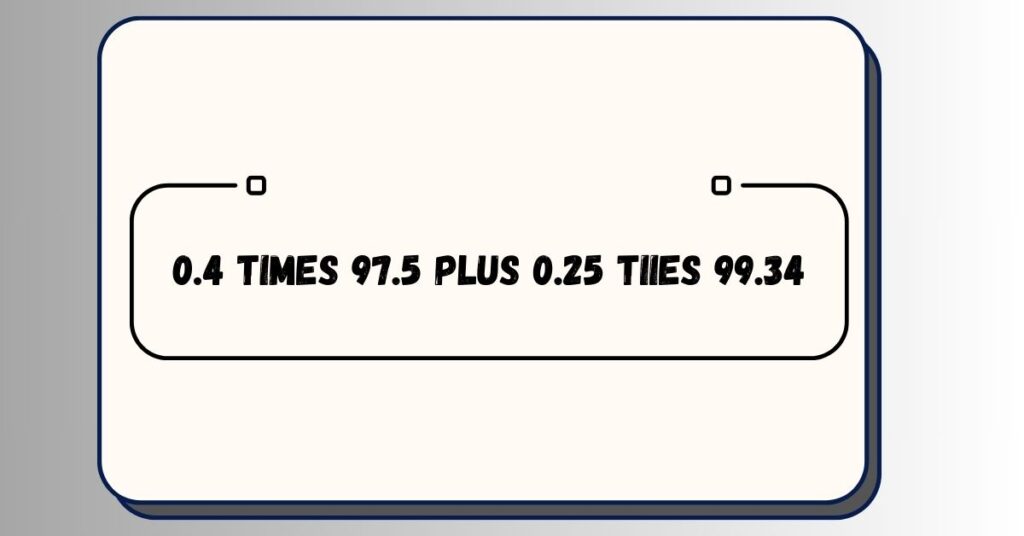Mathematics plays a crucial role in various aspects of our lives, from financial calculations to scientific measurements. One such mathematical operation is 0.4 times 97.5 plus 0.25 times 99.34, which might seem like a simple arithmetic expression but holds significance in different applications. In this article, we will break down this calculation step by step, explore its mathematical importance, and understand where such computations are used in real-life scenarios.
Understanding the Mathematical Expression
Before diving into the applications, let’s first solve the expression:
Step 1: Breaking Down the Expression
The given mathematical expression is:
0.4 × 97.5 + 0.25 × 99.34
To solve this, we need to compute the two multiplications first and then add the results.
Step 2: Performing the Multiplications
- 0.4 × 97.5
- 0.4 multiplied by 97.5 gives:
0.4 × 97.5 = 39.0
- 0.4 multiplied by 97.5 gives:
- 0.25 × 99.34
- 0.25 multiplied by 99.34 gives:
0.25 × 99.34 = 24.835
- 0.25 multiplied by 99.34 gives:
Step 3: Adding the Results
Now, we add the two obtained values:
39.0 + 24.835 = 63.835
Thus, the final result of 0.4 times 97.5 plus 0.25 times 99.34 is 63.835.
Importance of Arithmetic Operations
Arithmetic calculations, such as the one above, form the foundation of many fields, including engineering, finance, statistics, and everyday budgeting. The expression 0.4 times 97.5 plus 0.25 times 99.34 may seem random, but similar calculations are used frequently in real-world scenarios.
Applications of the Calculation
Let’s explore some practical applications where this type of arithmetic computation is relevant.
1. Financial Calculations
Financial analysts and accountants often perform calculations like 0.4 times 97.5 plus 0.25 times 99.34 to determine weighted averages, investment returns, or profit margins. For example:
- If 97.5 represents the price of an asset and 0.4 is the proportion of investment in it, the calculation helps determine the contribution of that asset to the total portfolio.
- Similarly, if 99.34 is another asset’s price and 0.25 is the proportion invested in it, this computation helps estimate the overall portfolio value.
2. Statistics and Weighted Averages
In statistical analysis, weighted averages are used to represent data more accurately. The calculation 0.4 times 97.5 plus 0.25 times 99.34 can be an example of a weighted mean formula used in:
- Student Grade Calculation: If a student’s grades in two subjects contribute differently to the final score, this kind of computation helps determine the weighted final grade.
- Survey Analysis: When evaluating survey results, responses might be weighted based on their importance or sample size, using similar calculations.
3. Engineering and Physics Applications
Engineering and physics involve numerous calculations where weighted values play a critical role. Examples include:
- Material Strength Calculations: Engineers calculate the combined strength of different materials based on their individual properties and their proportion in a structure.
- Physics Experiments: When dealing with mass distributions, force analysis, and energy calculations, weighted calculations like 0.4 times 97.5 plus 0.25 times 99.34 are frequently encountered.
4. Business and Market Analysis
Businesses often analyze market trends using weighted values. For example:
- If 97.5 represents customer satisfaction in one region with a 40% contribution to overall ratings and 99.34 represents satisfaction in another region with a 25% weight, the company can compute an overall rating using similar calculations.
- This type of analysis helps in making informed decisions about product improvements, service quality, and customer expectations.
5. Budget Planning and Expense Distribution
In personal finance or corporate budgeting, cost allocations often involve weighted multiplications. Consider:
- If 97.5 is the cost of a particular expense contributing 40% to the total budget and 99.34 is another expense with a 25% contribution, the calculation helps determine how much these expenses impact the overall budget.
How to Perform Such Calculations Easily
While solving 0.4 times 97.5 plus 0.25 times 99.34 manually is straightforward, there are many tools available to simplify calculations:
- Basic Calculators: Standard calculators allow quick multiplication and addition.
- Spreadsheets (Excel, Google Sheets): These tools enable users to automate weighted calculations for business or academic purposes.
- Programming Languages (Python, R, MATLAB): When handling large datasets, programming can help automate complex weighted calculations efficiently.
Example Using Excel
In Excel, you can compute 0.4 times 97.5 plus 0.25 times 99.34 using the formula:
excelCopyEdit= (0.4 * 97.5) + (0.25 * 99.34)
This will instantly return 63.835 as the result.
Example Using Python
For those comfortable with coding, Python provides an easy way to compute this:
pythonCopyEditresult = (0.4 * 97.5) + (0.25 * 99.34)
print(result)
This will output:
CopyEdit63.835
Conclusion
The calculation 0.4 times 97.5 plus 0.25 times 99.34 results in 63.835 and serves as a great example of arithmetic operations that have widespread applications in finance, statistics, engineering, and business. Whether you’re working on budget planning, investment analysis, or statistical computations, understanding such operations helps in making data-driven decisions.
By mastering fundamental arithmetic concepts like these, individuals and professionals can enhance their analytical skills and improve their problem-solving abilities in various domains.

